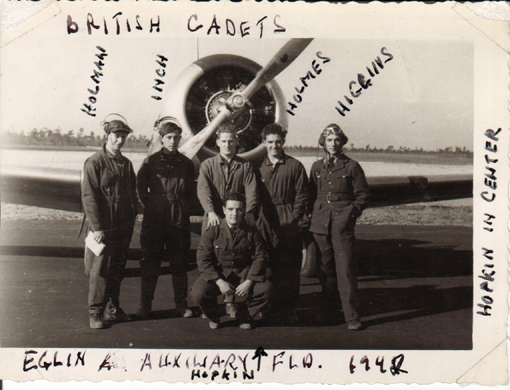
Les "British Cadets" de Robert C. Curtis

E.J.
Holman, D.F. Inch, S.W. Holmes, R. G. Higgins
Photograph taken at Crestview auxilliary field, Eglin Air Force Base, Florida,
in Jan., before the 19th. Each class went to Eglin for gunnery training. These
cadets were in the Class of 1942 B which graduated in Feb. '42.
I was a flight instructor in Advanced Flight Training. At this stage the trainees had been through Primary, and Basic Training; about 2 1/2 months each. After Basic Training pilots were sent to twin-engine, or single-engine Advanced Training, the former being prepared to fly bombers, the latter to fly fighters. I trained single-engine pilots in the North American Texan, called the AT-6 by the Army, the SNJ by the Navy and the Harvard by the British.

NORTH AMERICAN
TEXAN
Envergure : 12.60
m. Longueur 8,90 m
Poids en ordre de marche : 2600 Kg
Armement: aucun (quelques AT-6 ont été utilisés pour
l'entraînement au tir et au bombardement)
Engine: Pratt & Whitney R-1340 de 600 cv.
Vitesse maxi: 210 mph (345 Km/h)
Cruising speed: 145 mph (230 Km/h)
Rayon d'action : 770 miles (1230 Km)
Plafond : 23,200 pieds ( 7700 m)
Prior to July 1939 this training lasted a year, four months for each phase. In July 1939 a great expansion of the Army Air Corps began and each phase of training was reduced to about three months. In 1941 each phase was shortened to 2 1/2 months (10 weeks). In 1942, after Pearl Harbor, each phase was shortened again, to 9 weeks, but an additional 9 weeks of Preflight Training was added.
The
academic requirements also were gradually lowered from Bachelor's degree, before
1939, to two years of college (including physics and calculus), or passing an
exam on these subjects. After Pearl Harbor High School graduates were admitted
to flight training.
I taught three classes, 5 trainees in each, all of them British. This training
program for British pilots was phased out after Pearl harbor. Then I became
a Flight Leader and had no students of my own but gave flight tests to the students
of the instructors in my flight.
Advanced training consisted of learning formation flying, instrument flying,
night flying, navigation, and gunnery (firing the .30 caliber machine gun of
the AT-6 at towed targets.)
I'm attaching a photo of me with my first class of British students (At Napier
Air force Base, Dothan, Alabama, Spring 1942). The student kneeling in front
of me, Edgar Hopkin, was killed during a night flight. He tried to crash land
despite instruction that, if there is trouble on a night flight, you must bail
out and not try to crash land. Many pilots, however, did not trust their parachutes.
© R.C.Curtis , dec 13, 2001.
![]() Retour à l’introduction
Retour à l’introduction
![]() Retour au choix thématique
Retour au choix thématique
![]() Retour
à "souvenirs de guerre"
Retour
à "souvenirs de guerre"